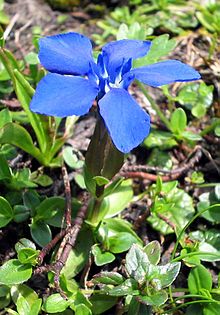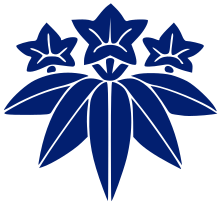Gentiana
| Gentiana | |
|---|---|

| |
| Gentiana verna | |
| Scientific classification | |
| Kingdom: | Plantae |
| Clade: | Tracheophytes |
| Clade: | Angiosperms |
| Clade: | Eudicots |
| Clade: | Asterids |
| Order: | Gentianales |
| Family: | Gentianaceae |
| Tribe: | Gentianeae |
| Subtribe: | Gentianinae |
| Genus: | Gentiana L. |
| Type species | |
| Gentiana lutea L. | |
| Species | |
|
See text | |
| Synonyms[1] | |
|
List
| |
Gentiana (/ˌdʒɛntʃiˈeɪnə/)[2] is a genus of flowering plants belonging to the gentian family (Gentianaceae), the tribe Gentianeae, and the monophyletic subtribe Gentianinae. With about 400 species, it is considered a large genus. Gentians are notable for their mostly large trumpet-shaped flowers, which are often of an intense blue hue.[3]
The genus name is a tribute to Gentius, an Illyrian king who may have discovered tonic properties in gentians.[4]
Habitat

This is a
Many gentians are difficult to grow outside their wild habitat, but several species are available in cultivation. Gentians are fully hardy and can grow in full sun or partial shade. They grow in well-drained, neutral-to-acid soils rich in humus. They are popular in rock gardens.
Uses
Many beverages are made with gentian root..
Gentian root is a common beverage flavouring for bitters. The soft drink Moxie contains gentian root.[7] The French apéritif Suze is made with gentian. Americano apéritifs contain gentian root for bitter flavoring.[8] It is an ingredient in the Italian liqueur Aperol. It is also used as the main flavor in the German after-dinner digestif called Underberg, and the main ingredient in Angostura bitters and Peychaud's Bitters.
The bitter principle of gentian root is primarily gentiopicrin (also called gentiopicroside),[9] a glycoside. A 2007 paper by a Japanese group identified 23 compounds in fresh gentian root.[10] Gentiopicrin was absent from fresh root, so it possibly develops during drying and storage of the root.
Gentian has had a limited use in perfumery, most notably as a glycerine soap (Crabtree & Evelyn) and a perfume (Corday's Possession, 1937).
Pharmacological uses
Gentiana punctata leaves and roots have been used in traditional Austrian medicine internally and externally as liqueur or tea for disorders of the gastrointestinal tract, skin, locomotor system, liver and bile, and for pediatric problems, fever, flu, rheumatism, and gout.[16]
Symbolism


The gentian flower was used as the emblem of the
Species
General
Gentians have oppositely arranged leaves, sometimes in a basal rosette. The trumpet-shaped
List of accepted species
- Gentiana acaulis – stemless gentian
- Gentiana affinis – pleated gentian
- Gentiana alata
- Gentiana alba – plain gentian
- Gentiana albicalyx
- Gentiana albomarginata
- Gentiana algida – whitish gentian
- Gentiana alii
- Gentiana alpina – alpine gentian
- Gentiana alsinoides
- Gentiana altigena
- Gentiana altorum
- Gentiana amplicrater
- Gentiana andrewsii – closed bottle gentian
- Gentiana angustifolia
- Gentiana anisostemon
- Gentiana aperta
- Gentiana apiata
- Gentiana aquatica
- Gentiana arenicola
- Gentiana arethusae
- Gentiana argentea
- Gentiana arisanensis
- Gentiana aristata
- Gentiana asclepiadea – willow gentian
- Gentiana asterocalyx
- Gentiana atlantica
- Gentiana atuntsiensis
- Gentiana austromontana – Appalachian gentian
- Gentiana autumnalis – pinebarren gentian
- Gentiana axilliflora
- Gentiana baeuerlenii (N.S.W)
- Gentiana bambuseti
- Gentiana bavarica – Bavarian gentian
- Gentiana beamanii
- Gentiana bella
- Gentiana bicuspidata
- Gentiana boissieri
- Gentiana bokorensis
- Gentiana borneensis
- Gentiana boryi
- Gentiana brachyphylla
- Gentiana bredboensis (N.S.W.)
- Gentiana bryoides
- Gentiana burseri
- Gentiana cachemirica
- Gentiana caelestis
- Gentiana caeruleogrisea
- Gentiana caliculata
- Gentiana calycosa – Rainier pleated gentian
- Gentiana capitata
- Gentiana carinata
- Gentiana carinicostata
- Gentiana caryophyllea
- Gentiana catesbaei – Elliott's gentian
- Gentiana cephalantha
- Gentiana cephalodes
- Gentiana chateri
- Gentiana chinensis
- Gentiana choanantha
- Gentiana chosenica
- Gentiana chungtienensis
- Gentiana clarkei
- Gentiana clausa – bottled gentian
- Gentiana clusii – trumpet gentian
- Gentiana confertifolia
- Gentiana coronata
- Gentiana crassa
- Gentiana crassicaulis
- Gentiana crassula
- Gentiana crassuloides
- Gentiana cristata
- Gentiana cruciata – cross gentian
- Gentiana cruttwellii
- Gentiana cuneibarba
- Gentiana dahurica
- Gentiana damyonensis
- Gentiana davidii
- Gentiana decemfida
- Gentiana decora – showy gentian
- Gentiana decorata
- Gentiana decumbens
- Gentiana delavayi
- Gentiana deltoidea
- Gentiana dendrologii
- Gentiana densiflora
- Gentiana depressa
- Gentiana dinarica
- Gentiana divaricata
- Gentiana diversifolia
- Gentiana douglasiana – swamp gentian
- Gentiana doxiongshangensis
- Gentiana dschungarica
- Gentiana duclouxii
- Gentiana durangensis
- Gentiana ecaudata
- Gentiana elmeriana
- Gentiana elwesii
- Gentiana emodi
- Gentiana ettingshausenii
- Gentiana exigua
- Gentiana expansa
- Gentiana faucipilosa
- Gentiana fieldiana
- Gentiana filistyla
- Gentiana flavomaculata
- Gentiana flexicaulis
- Gentiana formosa
- Gentiana forrestii
- Gentiana franchetiana
- Gentiana fremontii – moss gentian
- Gentiana frigida
- Gentiana froelichii – Karawanken gentian
- Gentiana futtereri
- Gentiana gelida
- Gentiana gentilis
- Gentiana georgei
- Gentiana gilvostriata
- Gentiana glauca – pale gentian
- Gentiana grandiflora
- Gentiana grata
- Gentiana grumii
- Gentiana gyirongensis
- Gentiana handeliana
- Gentiana haraldi-smithii
- Gentiana harrowiana
- Gentiana haynaldii
- Gentiana heleonastes
- Gentiana helophila
- Gentiana hesseliana
- Gentiana hexaphylla
- Gentiana himalayensis
- Gentiana hirsuta
- Gentiana hohoxiliensis
- Gentiana hooperi
- Gentiana hugelii
- Gentiana huxleyi
- Gentiana infelix
- Gentiana intricata
- Gentiana Inverleith
- Gentiana jamesii
- Gentiana jarmilae
- Gentiana jingdongensis
- Gentiana jouyana
- Gentiana kaohsiungensis
- Gentiana kauffmanniana
- Gentiana khammouanensis
- Gentiana kurroo
- Gentiana kwangsiensis
- Gentiana lacerulata
- Gentiana laevigata
- Gentiana langbianensis
- Gentiana lateriflora
- Gentiana lawrencii
- Gentiana laxiflora
- Gentiana leptoclada
- Gentiana leroyana
- Gentiana leucomelaena
- Gentiana lhassica
- Gentiana liangshanensis
- Gentiana licentii
- Gentiana ligustica
- Gentiana linearis – narrowleaf gentian
- Gentiana lineolata
- Gentiana linoides
- Gentiana loerzingii
- Gentiana longicollis
- Gentiana loureiroi
- Gentiana lowryi
- Gentiana lutea – great yellow gentian
- Gentiana lycopodioides
- Gentiana macrophylla – bigleaf gentian
- Gentiana makinoi
- Gentiana microdonta
- Gentiana newberryi – Newberry's gentian
- Gentiana nipponica
- Gentiana nivalis – snow gentian
- Gentiana nubigena
- Gentiana occidentalis - Pyrenean trumpoet gentian
- Gentiana ochroleuca
- Gentiana olgae
- Gentiana olivieri
- Gentiana orbicularis – round leaved gentian
- Gentiana ornata
- Gentiana pannonica – brown gentian
- Gentiana paradoxa
- Gentiana parryi – Parry's gentian
- Gentiana pedicellata
- Gentiana pennelliana – wiregrass gentian
- Gentiana phyllocalyx
- Gentiana platypetala – broadpetal gentian
- Gentiana plurisetosa – bristly gentian
- Gentiana pneumonanthe – marsh gentian
- Gentiana prolata
- Gentiana prostrata – pygmy gentian
- Gentiana przewalskii
- Gentiana pterocalyx
- Gentiana puberulenta – downy gentian
- Gentiana pumila
- Gentiana punctata – spotted gentian
- Gentiana purpurea – purple gentian
- Gentiana pyrenaica
- Gentiana quadrifolia
- Gentiana rigescens
- Gentiana rostanii
- Gentiana rubricaulis – closed gentian
- Gentiana saponaria – harvestbells gentian
- Gentiana saxosa
- Gentiana scabra
- Gentiana scarlatina
- Gentiana sceptrum – king's scepter gentian
- Gentiana sedifolia
- Gentiana septemfida – crested gentian
- Gentiana setigera – Mendocino gentian
- Gentiana setulifolia
- Gentiana sikkimensis
- Gentiana sikokiana
- Gentiana sino-ornata – showy Chinese gentian
- Gentiana siphonantha
- Gentiana speciosa
- Gentiana squarrosa
- Gentiana stictantha
- Gentiana stragulata
- Gentiana straminea
- Gentiana tenuifolia
- Gentiana terglouensis – Triglav gentian
- Gentiana ternifolia
- Gentiana tianshanica – Tienshan gentian
- Gentiana trichotoma
- Gentiana triflora
- Gentiana trinervis
- Gentiana tubiflora
- Gentiana uchiyamai
- Gentiana ulmeri
- Gentiana uniflora
- Gentiana urnula
- Gentiana utriculosa – bladder gentian
- Gentiana vandellioides
- Gentiana vandewateri
- Gentiana veitchiorum
- Gentiana venosa
- Gentiana venusta
- Gentiana verna – spring gentian
- Gentiana vernayi
- Gentiana viatrix
- Gentiana villifera
- Gentiana villosa – striped gentian
- Gentiana waltonii
- Gentiana walujewii
- Gentiana wangchukii
- Gentiana wasenensis
- Gentiana wilsonii
- Gentiana winchuanensis
- Gentiana wingecarribiensis (N.S.W.)
- Gentiana wissmannii (N.S.W)
- Gentiana wootchuliana – Korean alpine gentian[18]
- Gentiana xanthonannos
- Gentiana yakushimensis
- Gentiana yokusai
- Gentiana yunnanensis
- Gentiana zekuensis
- Gentiana zollingeri
Formerly placed here
This section needs expansion. You can help by adding to it. (April 2012) |
- Gentianopsis crinita (fringed gentian), as Gentiana crinita
Cultivation

Several gentian species may be found in cultivation, and are valued for the unusual intensity of their blue flowers. They have a reputation for being difficult to grow. All require similar conditions – moist, rich, free-draining soil with an acid to neutral pH. They include:[3]
In addition, the following cultivars, of mixed or uncertain parentage, have gained the Royal Horticultural Society’s Award of Garden Merit:[20]
References
- ^ "Gentiana Tourn. ex L." Plants of the World Online. Board of Trustees of the Royal Botanic Gardens, Kew. 2017. Retrieved 6 July 2020.
- ISBN 978-0-376-03850-0.
- ^ ISBN 978-1-4053-3296-5.
- ISBN 978-0-520-00606-5.
Gentiana gentius.
- ^ Strewe L. "Ethnobotany of gentians". Gentian Research Network.
- ^ "Espace Avèze | Office de Tourisme du Pays de Salers".
- ^ Orchant R (March 1, 2013). "Moxie: The distinctively different soda that New England loves". The Huffington Post.
- ^ "Quinquina & Americano by Brand". Vermouth 101.
- ^ PubChem. Gentiopicroside. https://pubchem.ncbi.nlm.nih.gov/compound/Gentiopicrin
- ^ "Gentian". WebMD.
- PMID 20734279.
- PMID 11474820.
- PMID 16257245.
- PMID 26074998.
- PMID 23770053.
- ^ "The Plant List: Gentiana L." Royal Botanic Gardens, Kew and Missouri Botanic Garden. 2013. Retrieved 26 May 2016.
- ISBN 978-89-97450-98-5. Archived from the original (PDF) on 25 May 2017. Retrieved 16 December 2016 – via Korea Forest Service.
- ^ "The Plant List: A working list of all plant species".
- ^ "AGM Plants – Ornamental" (PDF). Royal Horticultural Society. July 2017. p. 42. Retrieved 27 February 2018.
- ^ "Gentiana 'Blue Silk'". RHS Plantfinder. Royal Horticultural Society. Retrieved 27 February 2018.
- ^ "Gentiana 'Shot Silk'". RHS Plantfinder. Royal Horticultural Society. Retrieved 27 February 2018.
- ^ "Gentiana 'Strathmore'". RHS Plantfinder. Royal Horticultural Society. Retrieved 27 February 2018.
Further reading
- Struwe L, Albert VA, eds. (2002). Gentianaceae. Cambridge University Press. ISBN 978-0-521-80999-3.
- "Gentian Research Network".
External links
- . Encyclopedia Americana. 1920.
- . New International Encyclopedia. 1906.
